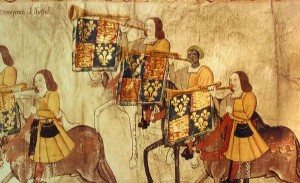John Lilburne
Occidental Observer
October 23, 2013
Editor’s note: John Lilburne’s article on White slavery reminds us that for long stretches of the history of England, elites have behaved in a viciously exploitative manner toward others, including other Whites. In the Fall issue of The Occidental Quarterly on White pathology (print version in press, electronic version available now), Yggdrasil notes of the period from the 16th to the 18th century in England:
The key point here is that the vast majority of Englishmen at the time were slaves in all but name, but since they were not chattel property, no one was bound by law or resale value to take reasonable care of them. Say what you like about the evils of slavery, as chattel property, slaves had a place and a value in society. In effect, the majority of “free” Englishmen at the time were an alien race with no place or value in society and no rights whatsoever.
The small minority in control feared and hated them, to a much greater degree than modern White liberals despise hillbillies, and sought to expel them to distant colonies as a means of suppressing future rebellions.
Of course, this is not the whole story, but it is an important part of it. The other part, in a nutshell, is the rise of egalitarian universalism beginning with the English Civil War of the 17th century. This revolution eventually resulted in the popular movement that resulted in the abolition of slavery in the 19th century motivated by moral idealism and embedded in various sects of Protestantism, as discussed in the Summer issue of TOQ (subscribe). This campaign against slavery, which occurred at a time when slavery was ubiquitous in all other culture areas (and remains common today in many countries), in turn has enabled an even more dangerous White pathology—the obsessive White guilt and pathological altruism that pervade the contemporary West and that are continually promoted by our hostile elite.
________________________________________________________________________________________________________________
Of the Europeans brought to America no fewer than 75% were indentured servants or convicts.
(Power and Plenty, Trade war and the world economy in the Second Millennium, Ronald Findlay and Kevin O’Rourke,231)
Definitive characteristics of slaves are as follows: their labour or services are obtained through force; their physical beings are regarded as the property of another person, their owner; and they are entirely subject to their owner’s will.
Encarta definition of slavery
This article explores the little known history of White slavery in North America.
What is meant by White slavery? The dictionary definition above shows it means forced labour, imposed by violence with the state acting to maintain legal status of the slave.
Oligarchs, Slaves and Tudor and Stuart Britain
Slavery in the west waxed and waned according to the demands and attitudes of the elites , the economic situation and the resistance of the populace. The opening up of the trade routes created the opportunity for enslavement of different groups, and the constant Islamic predations on the coasts of Europe (even as far away as Iceland) set an example that could be followed.
In Tudor England there were some Black slaves, who were later removed in Elizabethan times.[1]
During Elizabethan times the English were proud of their freedom as recorded in the Shakespearean plays. Such were the early Elizabethan times that, in England in the 1570’s Ralph Holinshead could boast.
As for slaves and bondsmen, we have none such as the privilege of our country by the special grace of God and the bounty on a prisoner that if anyone came hither from other realms so soon as they set foot on land they became free. [2]
However, shortly afterwards, as James I came to power, the economic situation darkened. Vagrants were seen as a threat to the public order. America began to be seen as a solution to a problem: partly the New Atlantis of Sir Francis Bacon and the socialist Utopia of Thomas More, but also as a potential dumping ground for the unwanted masses. Elites saw that the masses could be enslaved and used to acquire instant riches from gold.[3] Thus by the 1590’s, the punishment for being a vagrant was being discussed as eternal banishment:
who would not be reformed of their roguishness or life shall be banished out of this realm and shall be conveyed into such parts beyond the seas.[4]
Sir John Popham was one of the first of the English elite to begin to see the possibility of transportation of unwanted Englishmen to America as a practical concern and sought a charter for his Plymouth Company to achieve those ends. This was aligned with desire for gold. As a result, between 1606 and 1607 ships were sent to America with cargoes of convicts and adventurers.
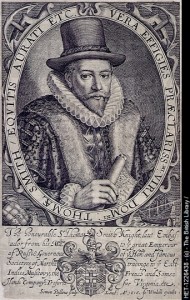
Beginning in 1615 the Privy Council promoted the enslavement and transportation of “convicts” to the Americas — convicts being the catch-all term for those that they considered undesirable. The Privy Council were not being merciful; their stated aim was that the transported be “constrained to toil in such heavy and painful works as such servitude shall be greater terror than death itself.”
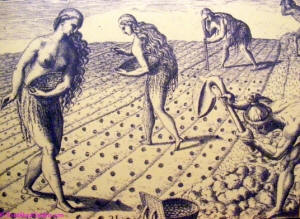
However it did not stop with the enslavement of people who committed crimes. Being in the wrong place at the wrong time could result in being forced into servitude. As the opportunity for wealth increased, so did the rapaciousness of the elite, and as the demand for labour increased so the circle of enslavement started to include anyone whom they could lay their hands on.
From these forces arose the classes that initially colonized America and the Caribbean.
These were:
- the oligarchs and ship owners who had capital and position who were in command of the colonization attempts;
- the free will indentured servants, who had neither capital or land who sold themselves into bondage for a period in return for passage in the hopes of eventual freedom and the ability to own their own land. Often they managed neither, and they often lived a life of hardship after their period of indenture; Some of the indentured servants were skilled craftsmen who were highly valued workers
- the criminals and political prisoners who were not even offered the choice and were simply transported;
- the kidnapped — people who were simply kidnapped, spirited away and used as slaves without even the pretence a trial or justice. The magistrates of the day were bribed to look the other way.

Slaves or Servants
The term used for the people taken from the UK was ‘indentured servants’, described in many textbooks as people who paid for their transportation by agreeing to work for a certain period, usually 7–14 years.
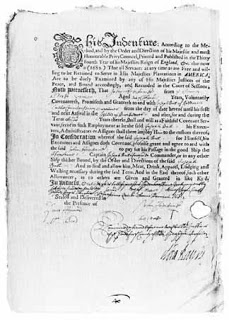
Today, when we talk of servants we think of domestic servants as having fairly menial but not uncomfortable jobs. The word ‘servant’ in the 16th and 17th centuries had other connotations. It mirrored the King James English from the Bible and it meant slave; people of the time would use the words interchangeably.
In reality the Whites were slaves; they lost the right of movement, the right to marry, the right to work for themselves and all the other opportunities that we take for granted.
The treatment of “servants” was exactly what you have seen in films about American Blacks and of their treatment for slaves–that is shackled, flogged, mistreated, without the effective protection of the law. A portion of indentured servants were skilled tradesmen, nonetheless even these were not free and could be subject to arbitrary treatment of their master. It should be noted that relationships between slave and master were not always necessarily bad or harsh. In all times and ages there were good bosses and bad bosses, and, as discussed below, the threat of slave revolts and market restraints effectively limited the master’s power. [8]
Nevertheless, the law was weighted against the slaves. For instance, if a White woman was raped or seduced by the master, then additional fines and servitude was imposed — on the servant, not on the master! Any children born were kept as slaves until age 21 and could be sent away from the parents as the owners wanted. If the servant ran away, he or she could be dragged back and punished both physically and with extra servitude. The only real privilege you had as a White was that you couldn’t be owned by a Black or a Jew.

From there grew the profitable (for the oligarchs) practice of sending forced labour to America. The swathe of people transported was in the end not limited to those who might be real criminals but, as noted above, anyone at the wrong time and place could be convicted of vagrancy and transported. As the demand for labour grew, it encompassed whole categories of “political” prisoners that the powers of the day wished to punish. Cromwell took Irish as slaves.9 The royalists enslaved Calvinists, and anyone on the wrong side of the royals could be sent as a “convict” to the Americas.
Black and White
In 1619 the first boat of about 20 Blacks were brought as slaves to America aboard the English/Dutch ship, the White Lion. Or more precisely, they were brought in as indentured servants as the legal framework for White and Black were exactly the same. No flood of Blacks followed because there were sufficient White slaves for the purposes needed. Racism may well have existed but the rush for profit dominated, and White and Black servants worked in the field and house together. So naturally Blacks and Whites were enslaved together, deserted together and were flogged together.[10]
At that stage the vilification of White female slaves meant that they were treated as whores and prostitutes; some fell into having relationships with Blacks. The authorities later started creating laws against miscegenation; they did not follow the policy of the Arabs by encouraging deliberate miscegenation between slaves (if they were privileged enough to survive) in order to produce a new people without history or identity—a slave class easy to control and manipulate (see White Gold by Giles Milton).
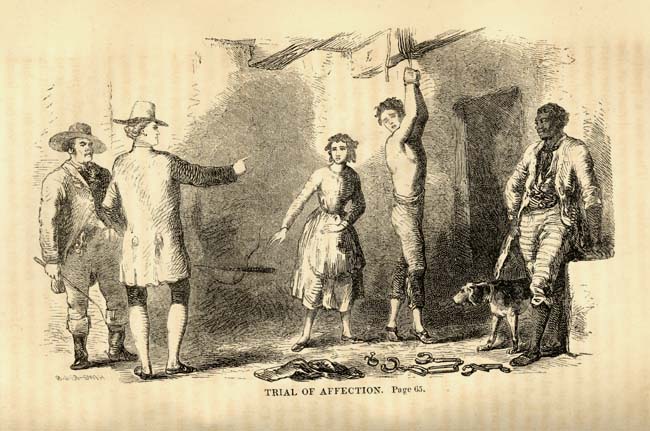
If you were a runaway White slave, you would be hunted down until you as property to be returned to the owner. Thereupon you could be flogged and extra years added to your servitude. And if you were flogged to death, the local magistrates would usually excuse the murder as the owner was often part of their circle of friends. [11]
Things started to change between White and Black in the 1640s and early 1650s. A wealthy plantation owner, Anthony Jonson, brought a case to court of a deserted Black slave to force him into lifelong slavery. From that period on, lifelong slavery for Blacks started to become the norm. It is interesting that Anthony Johnson was a Black slave who probably came as one of the original batch from Angola in 1619. Massachusetts, that liberal bastion was one of the first states to implement lifelong slavery. Nevertheless, the vast majority of indentured servants were brought to the Southern states because of the need for labor on staple crops of tobacco and cotton.[12]
Also at this time there were a number of serious White slave mutinies, such as that in the Caribbean in the 1640’s which made the elites begin to be aware that they needed potential allies.[13]
Initially there was no difference between White and Black slavery. The legal basis was exactly the same. The structures that were later created around Black slavery were first created for White slavery in the initial years of British presence in America. However, due to White resistance to enslavement, the elites’ need for allies on a hostile continent, and probably some measure of feeling for fellow White Christians, there was a felt need for separate treatment of Whites and Blacks. Thus the legal status of Black and White started to diverge, with Black slavery being a lifetime status, while Whites’ servitude was limited to a period of several years. But in other ways, the practical status was unchanged. As part of the program for creating longer term allies for the elites, Virginia passed its first anti-miscegenation law in 1691 as part of a program that gave the elite “as many Virginians with a stake in suppressing servile insurrection as there were in fomenting it.”[14]
Since the service term of Whites was limited, they were often treated more harshly than Blacks whose status as a slave lasted for their entire lives. Since Whites were now of less value to slave owners, they were therefore given the more dangerous and difficult jobs. In practice, approximately 50% of Whites who were transported died in their servitude, so perhaps there was no great increase in White mortality.
The segregation of White and Blacks only began after Bacon’s Rebellion of 1676 when White and Black combined to fight against the governor. The oligarchs then realized that they needed a policy of divide and rule to maintain their power.
It did not mean however the end of servitude for Whites. Convict slaves were still being transported right up to the US Revolutionary War. Convict labour was a third the price of Black slaves and could be used in harsher environments than Black slaves. The percentage of convict versus indentured is not clearly discussed in the literature, partly because the gap between them was not that large. A convict would be considered to be indentured as part of his sentence. The reference to power and plenty at the beginning of the article effectively states only 25% of whites in the initial years went freely without any compulsion. Life, especially for convicts, could be short, brutish, and nasty. With death rates up to 50% , whether the sentence was 7 or 15 years mattered little. For many, it was effectively for life.[15]
However, as time progressed America became a more prosperous and safer place, and it became cheaper for independent travel from the UK and elsewhere in Europe. It became more common for immigrants to pay their own way and thus avoid a period of indentured servitude. These people moved freely and independently. Moreover, ultimately the descendants of the indentured servants could indeed become free. But it was only in 1865, with the Thirteenth Amendment to the United States Constitution, that slavery and involuntary servitude for Whites ended.
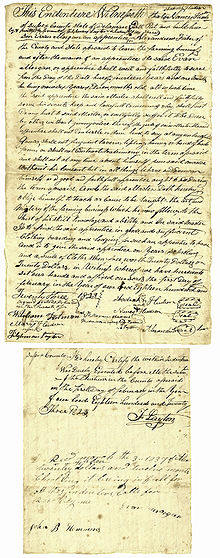
Poor White Trash
The book White Cargo describes how the body of a White slave was thrown out with the trash.[16] The attitude of British elites to poor Whites only slowly changed. Throughout the 18th century the poor lived a precarious existence. Australia became the new dumping ground of the unwanted. If one were unfortunate enough to end up in an 18th-century workhouse, there was 90% probability of dying. By the 19th century the situation was uncomfortable but survivable. Charles Dickens didn’t realize how lucky he actually was.
For many of the elite, poor Whites were lower than dogs in priority. The laws for the protection of cruelty to animals (1824) were instituted long before the laws protecting children (1889). The bishops in the House of Lords objected to child protection laws because they might affect “property rights.”
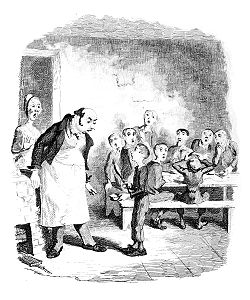
Many of the elite would weep over the cruelty to Negroes in America, but feel no pain about sending young chimney sweeps to death in a hot chimney, nor worry that such children were being bought and sold on the streets of London. Unfortunately, the tendency for the White oligarch to sympathise with the stranger over the neighbor still remains. A sad reality is that only when the oligarchs fear and respect the masses is there freedom and harmony, but when the elites distrust and dominate the rest, you tend to have oppression and inequality.
Myth and media- the time of forgetting
Why and when was the slavery of Whites removed from people consciousness? It happened at a very early stage in American history. Even as convicts were landing during the Revolutionary War, Jefferson was minimizing the role they had played in the peopling of America. Every country needs its founding myths, and at that time the founding myth of America was rebellion to achieve liberty.
As a result of the rise of the new elite in the media and academic world, Black slavery and the displacement of the Indians have become the original sin of America that can only be redeemed by the destruction and displacement of Whites. Many of the key facets of thought reform (isolation, guilt manipulation, conversion and confirmation; [17]) have been the applied relentlessly by the new elite to subjugate the minds of masses to create a new breed of compliant may I say… slaves.

